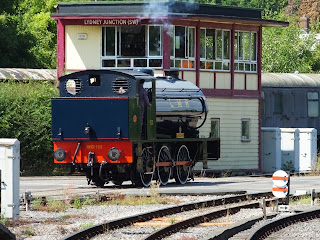(All pics 5.8.2018 copyright Steve Sainsbury/Rail Thing)
I managed my annual visit to a heritage railway on Sunday, visiting the Dean Forest Railway for the first time, despite it being less than an hour away.
The weather was hot and sunny, which proved to be the only downside of the day! I was immediately impressed by the facilities at Norchard, huge car park, excellent restaurant with an incredible range of vegetarian and vegan food. Lovely shop and a real bonus carriage full of nice, low priced, secondhand books.
The weather meant that steam was limited to the Norchard to Lydney Junction section, with a DMU service up to Parkend. Norchard has a strange layout with both low level and high level platforms, which made this operation straightforward.
We'd booked a cream tea trip along the line, the ticket was a rover ticket so before the 3 o'clock trip (which we assumed was going up to Parkend) we took a trip down to Lydney Junction. This is the more urban section of the route which threads through Lydney town itself with three level crossings, one manually operated. There's an intermediate station at Lydney Town, plus an abandoned station nearby. Lydney Junction is spacious and just 200 metres from the main line station.
Back at Norchard we discovered that the cream tea train wasn't going to Parkend as expected, but was going back down to the Junction! And our reserved seat was on the sunny side. We made it, just, but the heat won and we didn't take the train up to Parkend because of this.
Still a great day out, with a definite return to do the Parkend stretch on the cards and, hopefully by 2021, the new route beyond up to Cinderford.






















